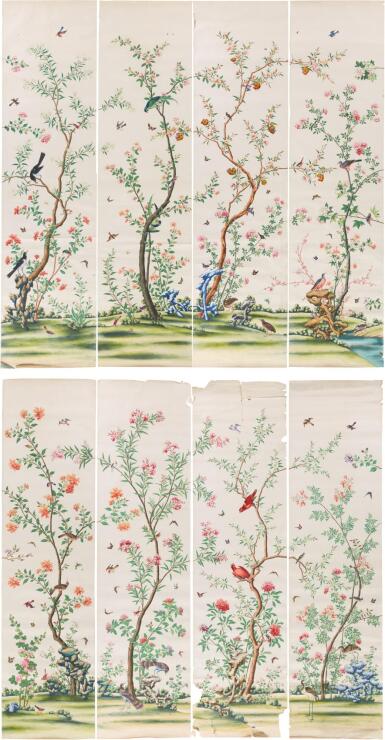
A SUITE OF TWENTY-FOUR CHINESE-EXPORT WALLPAPER PANELS, CIRCA 1790-1810
Auction Closed
December 11, 04:05 PM GMT
Estimate
50,000 - 100,000 GBP
Lot Details
Description
A SUITE OF TWENTY-FOUR CHINESE-EXPORT WALLPAPER PANELS, CIRCA 1790-1810
watercolour on paper, forming an aviary of exotic and wild birds amongst a forest of flowers, shrubs and trees, each numbered in manuscript to the reverse, several with Chinese characters
Photographed here before conservation by Allyson McDermott.
each approximately: 361cm. by 94cm., 11ft. 10in. by 3ft. 1in.
Probably Robert Berkeley (1764-1845)
Bird-and-flower motifs have a very long history in Chinese art and were already well established by the 10th century. In the 17th century, Chinese porcelain, silk and lacquer decorated with this kind of scenery began to make its way to north-western Europe, imported by the European ‘East India’ trading companies. Strong European demand then led to the production of Chinese luxury goods specifically for the western market. One of these hybrid products was pictorial Chinese wallpaper, which began to be imported into Europe in about 1750 and was often decorated with birds and flowers. The first examples were woodblock-printed, but from the 1760s onwards they were fully hand-painted.
Chinese bird-and-flower wallpapers can be difficult to date, as the Guangzhou painting workshops which produced them continued to deploy the same traditional auspicious motifs. In a few cases we do know when certain wallpapers were hung in specific European houses, which can give us an indication as to the dating of other comparable examples. And one can discern a gradual stylistic development in these wallpapers, from a rather painterly style in the 18th century to a more stylised appearance in the 19th century.
In the case of these Chinese wallpaper sheets from Spetchley Park, it is thought that they were acquired for the house in or before 1811, but were never used, which explains the undimmed freshness of the colours. The scenery displays some apparently 18th-century and some apparently 19th-century characteristics. The ground and the vegetation at the lower edge have been depicted in a naturalistic, softly undulating manner, the rugged silhouettes and textures of the tree trunks and branches has been subtly rendered and the leaves, flowers, birds and butterflies have been painted with great delicacy. All of this is reminiscent of the bird-and-flower wallpapers dated to the 1770s, such as those at Nostell Priory, West Yorkshire (hung 1771), Cobham Hall, Kent (supplied 1773) and Erddig, Wrexham (probably hung 1770s).[1] But interestingly the details and specific compositions that those wallpapers share are not seen in the Spetchley Park sheets, which, moreover, include more prominent decorative rocks and have a more open composition, stylistic trends that would continue in Chinese wallpapers dated to the 19th century.
In the 1790s the Guangzhou painting workshops began to introduce additional garden-related motifs to the bird-and-flower wallpapers, such as jardinières on stands and bird perches hung from the trees. Two related wallpapers with these new motifs, coloured partly en grisaille, survive at Houghton Hall, Norfolk, and at Temple Newsam, Leeds, where they appear to have been introduced in about 1797 and 1806, respectively.[2] Four sheets of the same pattern, but in full colour, are in the collection of the Victoria and Albert Museum, London.[3] Stylistically these appear quite close to the Spetchley sheets, which are therefore likely to have been produced at about the same time.
Emile de Bruijn
[1] Emile de Bruijn, Chinese Wallpaper in Britain and Ireland, London, Philip Wilson, 2017, pp. 109–19.
[2] Id., pp. 140–4 and pp. 152–5.
[3] Victoria and Albert Museum inv. nos. E.2851-1913 – E.2854-1913.
